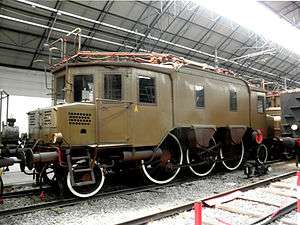FS Class E.330
Class E.330
 |
| Type and origin |
|---|
| Power type |
electric |
|---|
| Builder |
Westinghouse (Tecnomasio Italiana Brown Boveri) |
|---|
| Build date |
1914 |
|---|
| Total produced |
16 |
|---|
|
|
|
| Performance figures |
|---|
| Maximum speed |
100 km/h (62 mph) |
|---|
| Power output |
2,000 kW (2,700 hp) |
|---|
| Tractive effort |
84 kN (19,000 lbf) |
|---|
|
| Career |
|---|
| Operators |
FS |
|---|
| First run |
1914 |
|---|
| Retired |
1963 |
|---|
|
The FS Class E.330 was a small class of three-phase electric locomotive used in Italy, introduced in the 1910s.
History
In the late 1900s, the success of the three-phase electrification on mountains lines such the Valtellina line, the Simplon Tunnel and the Giovi Pass line, led the newly formed Ferrovie dello Stato, under the direction of Riccardo Bianchi, to extend the electrification to other lines, where electric locomotives granted better performances. For the new lines to be electrified, three batches of electric locomotives were ordered, including the E.330 and the E.550 (a type E.551 was ordered but not built).
Differently from the previous electric locomotives used on mountain lines, the new locomotives had to be able to vary their speed, a capability which at the time was problematic to achieve, due to the fact the three-phase motors spins at constant speed depending from the feeding current frequency. The E.330 was designed to have four speeds (where the E.430 had only one and the contemporary E.550 two); this capability was obtained thanks to two patents by the German engineer Manu Stern and the Hungarian engineer Maurice Milch.[1] The wheel arrangement chosen was 1-C-1, similar to that adopted on the contemporary 685 class of steam locomotives.
The production contract was signed in 1913, construction of the new units beginning at the Italian Westinghouse, which had designed the locomotive under the direction of Kálmán Kandó. The mechanical part was co-built with Società Italiana Ernesto Breda.
The locomotives were assigned to the Valtellina and Ligurian coast lines. The E.330s became operational in the Spring 1914. They were later used also in Lombardy on the local three-phase lines, until, from 1962, the railroads were adapted to the now standard 3,000 V direct current electrification.
All the E.330s were all phased out during the 1960s.
References
- ↑ Mascherpa, Erminio (1979). "Nascita dell'E.330". Italmodel ferrovie 29 (224-227): 14–22.
 |
Wikimedia Commons has media related to FS E.330. |